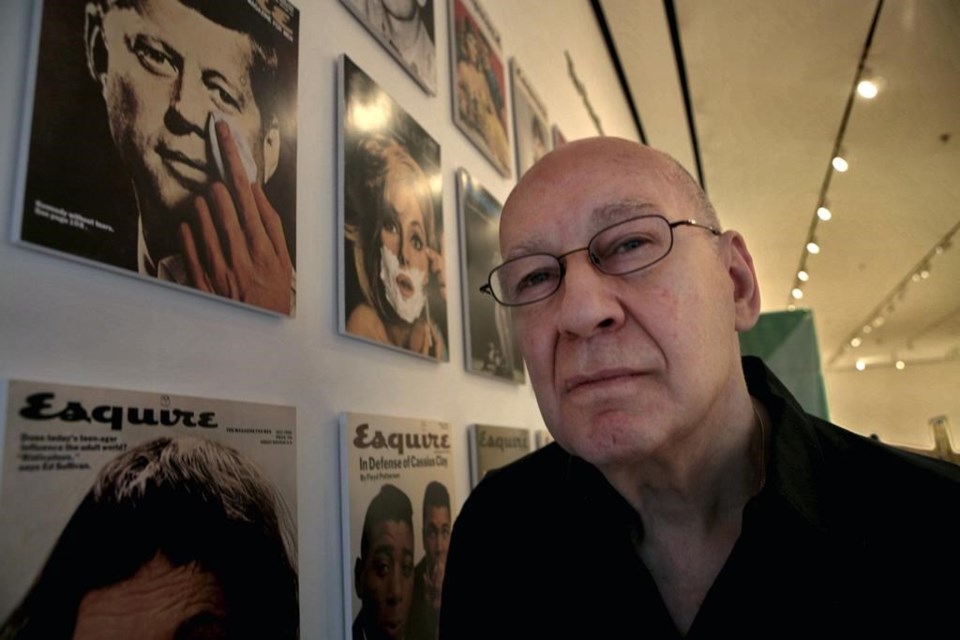NEW YORK (AP) ã George Lois, the hard-selling, charismatic advertising man and designer who fashioned some of the most daring magazine images of the 1960s and popularized such catchphrases and brand names as ãI Want My MTVã and ãLean Cuisine,ã has died. He was 91.
Lois' son, the photographer Luke Lois, said he died ãpeacefullyã Friday at his home in Manhattan.
Nicknamed the ãGolden Greekã and later (to his displeasure) an ãOriginal Mad Man,ã George Lois was among a wave of advertisers who launched the ãCreative Revolutionã that jolted Madison Avenue and the world beyond in the late 1950s and ã60s. He was boastful and provocative, willing and able to offend, and was a master of finding just the right image or words to capture a moment or create a demand.
His Esquire magazine covers, from Muhammad Ali posing as the martyr Saint Sebastian to Andy Warhol sinking in a sea of Campbellãs tomato soup, defined the hyper spirit of the ã60s as much as Norman Rockwellãs idealized drawings for the Saturday Evening Post summoned an earlier era. As an ad man, he devised breakthrough strategies for Xerox and Stoufferãs and helped an emerging music video channel in the 1980s by suggesting ads featuring Mick Jagger and other rock stars demanding, with mock-petulance, ãI Want My MTV!ã
Lois boiled it down to what he called the ãBig Idea,ã crystallizing ãthe unique virtues of a product and searing it into peopleãs minds.ã He was inducted into numerous advertising and visual arts halls of fame, and in 2008 his Esquire work was added to the permanent collection of the Museum of Modern Art. Martin Scorsese, Tina Brown and Graydon Carter were among his admirers.
His legacy was vast, although the actual dimensions are disputed. His claims to developing the 1960s ãI Want My Maypoã breakfast ads and to inspiring the creation of New York magazine have been widely contradicted. Some former Esquire colleagues would allege that he exaggerated his role at the expense of other contributors, such as Carl Fischer, who photographed many of the magazineãs famous covers. But his overpowering energy and confidence were well recorded.
In her memoir ãBasic Black,ã former USA Today publisher Cathie Black recalled bringing in Lois in the early 1980s to propose a new advertising approach for a publication that struggled at first over how to identify itself. Loisã idea was to champion USA Todayãs dual appeal as a newspaper and magazine, proposing the slogan, ãA lot of people are saying USA Today is neither fish nor fowl. Theyãre right!ã Before a gathering of the publication's, including founder Al Neuharth, Lois gave an Oscar-worthy performance, Black wrote, ãbounding in like a 6-foot-3 teenager hopped up on Red Bull.ã
ãHe flung his jacket to the floor, tore off his tie, then flashed one prototype ad after another, prancing around the room and keeping up a running monologue sprinkled with jokes and profanity. It was epic, almost scary. I was thrilled. When he was finished, the room sat absolutely silent.ã All eyes turned to Neuharth, who sat ãabsolutely still, his expression hidden behind his dark aviator glasses.ã Neuharth paused, removed his glasses and smiled. ãWeãve got it,ã he said.
Lois' longtime wife, Rosemary Lewandowski Lois, died in September. A son, Harry Joseph Lois, died in 1978.
Lois, the son of Greek immigrants, was born in New York City in 1931 and would cite the racism of his Irish neighborhood for his drive ãto awaken, to disturb, to protest.ã He liked to say that a successful advertiser absorbed as many influences as possible, and he prided himself on his knowledge of everything from sports to ballet. He was a compulsive drawer and for much of his life made weekly visits to the Metropolitan Museum of Art.
He enrolled in Pratt Institute, soon met his future wife and eloped with her before either had graduated. After serving in the Army during the Korean War, he joined the advertising and promotion department of CBS and in 1960 helped found the advertising agency Papert Koenig Lois. Two years later he was recruited by Esquire editor Harold Hayes and remained until 1972, the same year Hayes left.
Esquire was a prime venue for the so-called New Journalism of the 1960s, nonfiction stories with a literary approach, and the magazine would publish such celebrated pieces as Gay Taleseãs portrait of Frank Sinatra and Tom Wolfeãs ãThe Last American Hero Is Junior Johnson. Yes!ã But to read the words, you had to buy the magazine, and Loisã covers launched countless conversations.
For a cover story on ãThe New American Woman,ã he featured a naked model folded into a garbage can. A notorious 1970 cover showed a grinning Lt. William Calley, the serviceman later found guilty of murdering unarmed civilians in the My Lai Massacre, with his arms around a pair of Vietnamese children, two other kids behind him.
In the mid-1970s, Lois was among the public figures who led efforts to free the boxer Rubin ãHurricaneã Carter from prison. Carterãs conviction for murder was later overturned, and he was released in 1985. Lois also wrote several books and was featured in the 2014 documentary about Esquire, ãSmiling Through the Apocalypse.ã
Interest in Lois was renewed through the popularity of the AMC series ãMad Men,ã but he was not flattered, writing in his book ãDamn Good Adviceã that the show was ãnothing more than a soap opera set in a glamorous office where stylish fools hump their appreciative, coiffured secretaries, suck up martinis, and smoke themselves to death as they produce dumb, lifeless advertising.ã
ãBesides,ã he added, ãwhen I was in my 30s I was better looking than Don Draper.ã
Hillel Italie, The Associated Press



